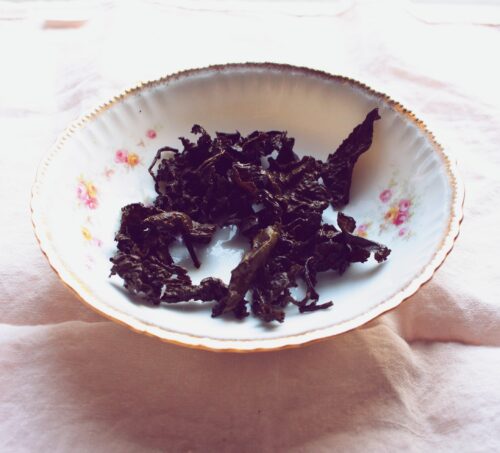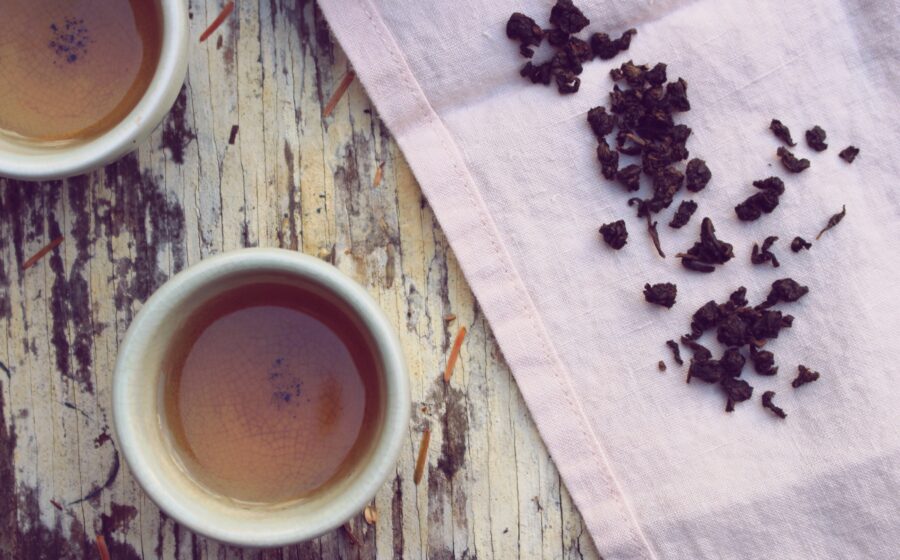[T]he first snowflakes have fallen and we’re whole-heartedly remedying the deep chill with warming sensations and flavors. While we tightly close our windows and doors, the natural world is creating gems to bring to the table. Root vegetables and dark greens flourish in winter weather. Tea harvests follow the same notion of seasonality, with harvests taking place throughout the year that vary in taste. Oolong teas harvested during winter and spring seasons are considered by some to be ideal, as the weather is cooler and fog is present, resulting in a better leaf. While spring harvest obviously leans towards more floral flavors, winter oolongs harvested from October through November have a distinct sweetness that is intensified when roasted. The practice of roasting oolongs is common with winter harvests and can range from medium to dark.
While spring harvest obviously leans towards more floral flavors, winter oolongs harvested from October through November have a distinct sweetness that is intensified when roasted.
To truly enjoy tea at its peak flavor it’s best to steep in season, which is why I jumped at the chance to sip Teance’s Tieguanyin Dark Roast (Monkey Picked) Oolong tea. This tea was harvested for winter 2014 in the Anxi County in the Fujian province of China, where tieguanyin production is low, making the tea prized. In his Tea Dictionary, James Norwood Pratt notes that Anxi tieguanyin “has a history of over 200 years and is one of China’s 10 Most Famous Teas celebrated for intensity of aroma, fruitiness and depth of flavor.” Named after the Chinese goddess of mercy, Guan Yin, this particular tieguanyin oolong is sixty to seventy percent oxidized and then roasted over charcoal heat for twenty hours. This intense roasting process is noted with the “dark” descriptor. “Monkey picked” tea is commonly, and understandably, mistaken as tea that has been picked by monkeys. Rather, Teance notes that this tea has been “grown at high elevations and steep hillsides of seventy-degree slopes, making it almost impossible for humans to harvest.” Hand-harvested deep in the Treasure Mountain, the highest mountain in Anxi, directional breeze, fog, and spring water lead to optimal growth and pest resistance.
To elaborate on that growth and the tea’s treasured qualities, Winnie Yu, director and tea buyer at Teance, notes that “foggy conditions are always good for tea growth, as it actually slows the leaves from turning thick and waxy, leaving softer and smaller leaves to grow slowly but with more intense flavors. Tea plants do not like pooling water or too much rain. Rather, a constant source of aerial moisture is best, like foggy cloudy mountains. Tea plants are also best grown on steep inclines so that the mountain springs trickle downward without pooling. The best oolongs grow on elevations of 800 meters or more, under intense cloud cover, preferably with a nice breeze that blows away any bugs, if the cooler temperatures in a high mountain hasn’t already done so.”

Multiple infusions call for sharing cups of the tea with friends around a table, possibly pairing it with small bites of dark chocolate.
Encouraging us to linger closer to the kettle a bit longer than a simple steep, sip, and run, this tieguanyin can be steeped up to six times. And really, isn’t that what winter is all about? We’re often seeking ways and reasons to spend more time tucked beneath our blankets or with our hands nestled around a cup of tea. The multiple infusions call for sharing cups of the tea with friends around a table, possibly pairing it with small bites of dark chocolate. As we continue to re-steep the dark roasted oolong leaves they unfurl, releasing a variety of complex flavors. Think of this tieguanyin as a treasured novel: the pages turning to uncover even richer stories.
—Alexis Siemons is a tea writer and consultant. She writes about her steeped adventures at teaspoonsandpetals.com.
















